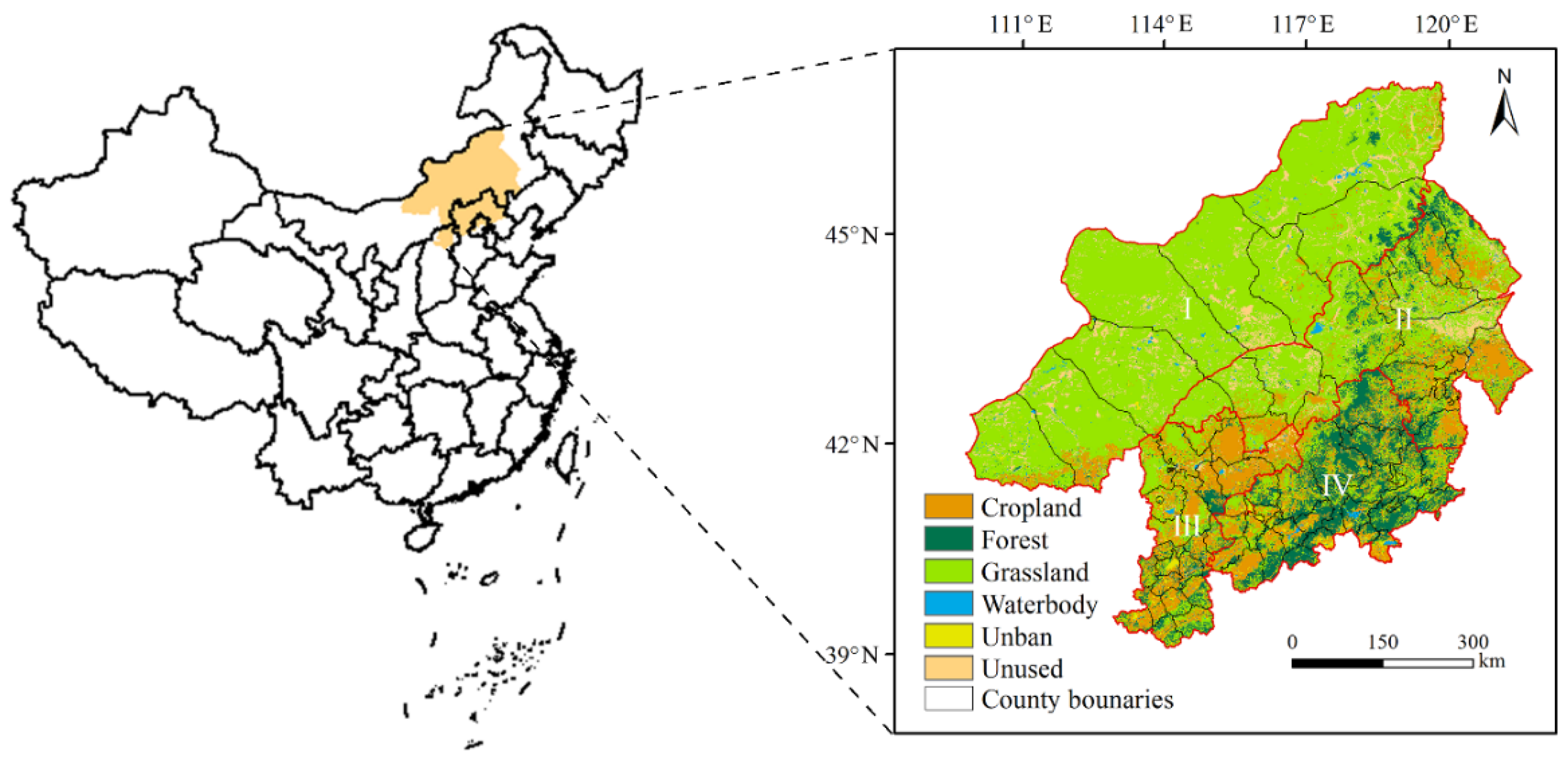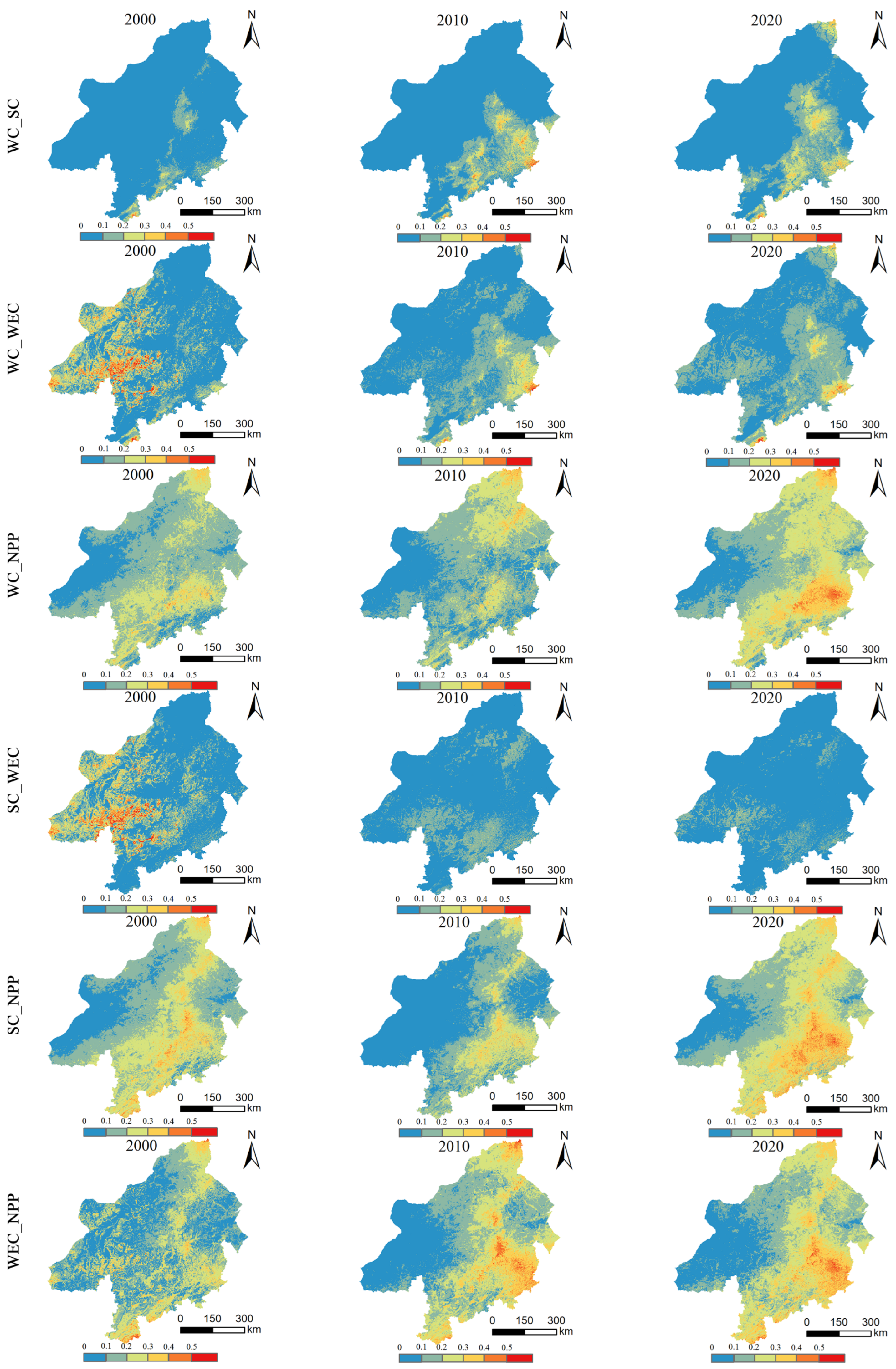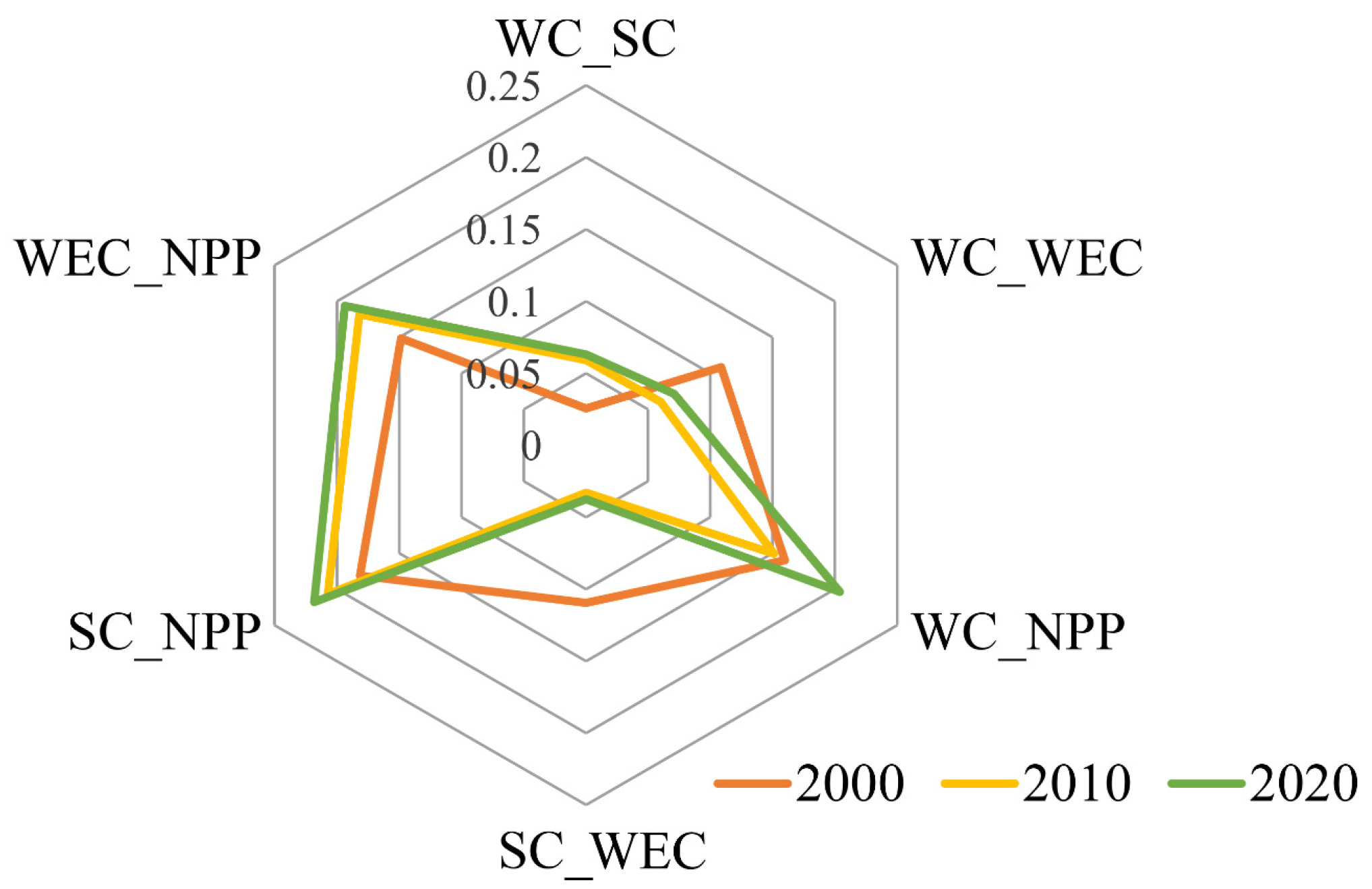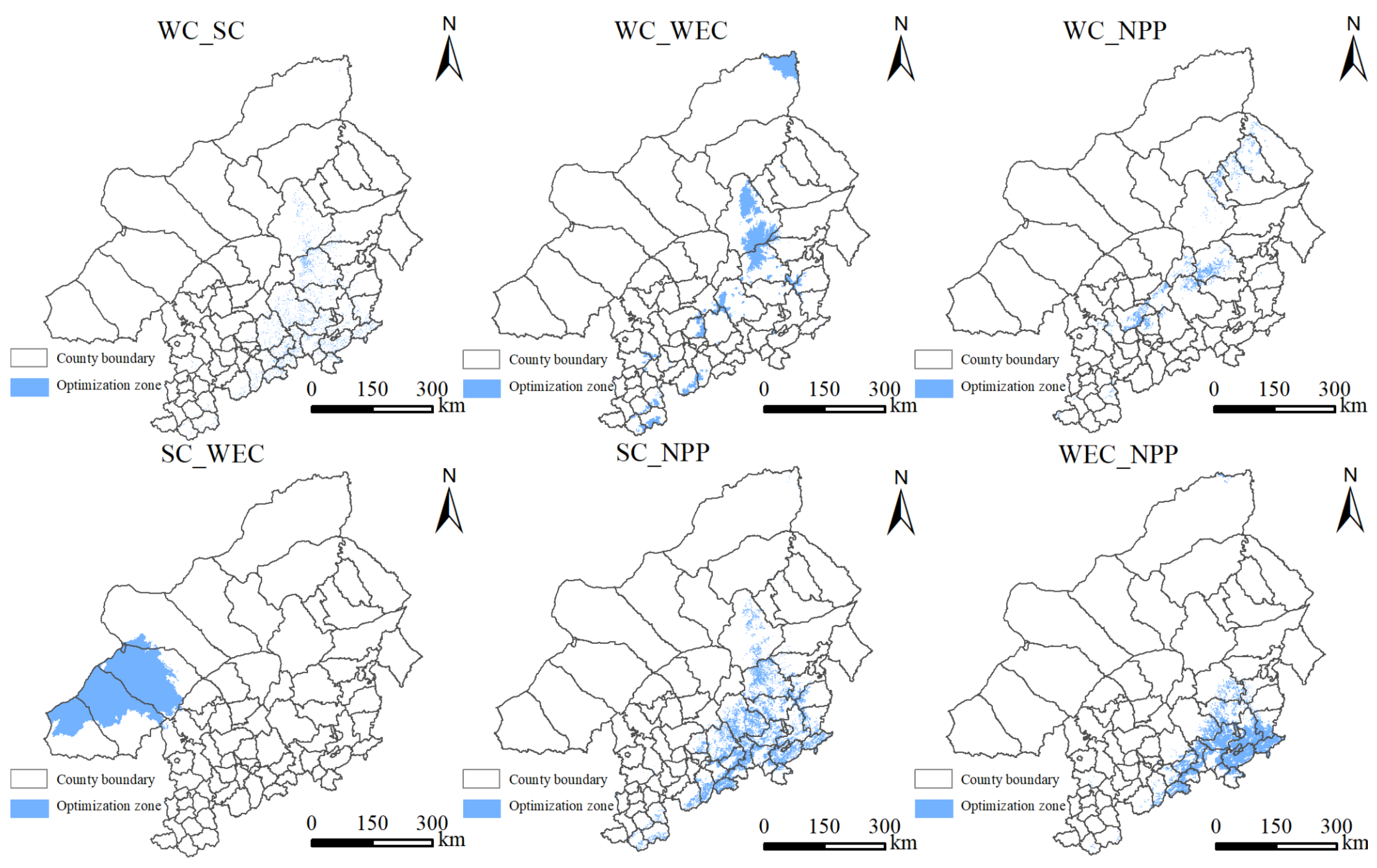Spatiotemporal Patterns and Drivers of Trade-Offs and Synergy in the Beijing–Tianjin Sand Source Control Project: A Bayesian Belief Network-Based Analysis
Abstract
1. Introduction
2. Materials and Methods
2.1. Study Area Overview
2.2. Data Sources
2.3. Methods of Assessment
2.3.1. Water Conservation
2.3.2. Soil Conservation
2.3.3. Wind Erosion Control
2.3.4. Net Primary Productivity
2.3.5. Trade-Offs and Synergies of Ecosystem Services
2.3.6. Modeling Ecosystem Services Based on the BBN
3. Results
3.1. Spatiotemporal Analysis of Ecosystem Services
3.2. Synergistic Ecosystem Service Trade-Offs
3.2.1. Correlation Analysis of Ecosystem Services
3.2.2. Analysis of the Trade-Offs among Ecosystem Services
3.3. Construction and Validation of the BBN
3.4. Spatial Optimization of Ecosystem Services
3.4.1. Sensitivity Analysis
3.4.2. Spatial Optimization of Ecosystem Services
4. Discussion
4.1. Interactions among Ecosystem Services
4.2. Mechanisms Driving Ecosystem Service Trade-Offs
4.3. Limitations of the Model
4.4. Implications for Future Ecosystem Management
5. Conclusions
Supplementary Materials
Author Contributions
Funding
Institutional Review Board Statement
Informed Consent Statement
Data Availability Statement
Acknowledgments
Conflicts of Interest
References
- Costanza, R.; D’arge, R.C.; Groot, R.D.; Farber, S.B.; Grasso, M.; Hannon, B.M.; Limburg, K.E.; Naeem, S.; O’Neill, R.V.; Paruelo, J.M.; et al. The value of ecosystem services: Putting the issues in perspective. Ecol. Econ. 1998, 25, 67–72. [Google Scholar] [CrossRef]
- Millennium Ecosystem Assessment. Ecosystems and Human Well-Being; Island Press: Washington, DC, USA, 2005. [Google Scholar]
- Fu, B.; Zhang, L. Land-use change and ecosystem services: Concepts, methods and progress. Prog. Phys. Geogr. 2014, 33, 441–446. [Google Scholar] [CrossRef]
- Costanza, R.; Groot, R.D.; Braat, L.C.; Kubiszewski, I.; Fioramonti, L.; Sutton, P.C.; Farber, S.B.; Grasso, M. Twenty years of ecosystem services: How far have we come and how far do we still need to go? Ecosyst Serv. 2017, 28, 1–16. [Google Scholar] [CrossRef]
- Wang, P.; Zhang, L.; Li, Y.; Jiao, L.; Wang, H.; Yan, J.; Lu, Y.; Fu, B. Spatio-temporal characteristics of the trade-off and synergy relationships among multiple ecosystem services in the Upper Reaches of Hanjiang River Basin. Acta Geogr. Sin. 2017, 72, 2064–2078. [Google Scholar] [CrossRef]
- Rodríguez, J.P.; Beard, T.D.; Bennett, E.M.; Cumming, G.S.; Cork, S.J.; Agard, J.; Dobson, A.P.; Peterson, G.D. Trade-offs across Space, Time, and Ecosystem services. Ecol. Soc. 2006, 11, 709–723. [Google Scholar] [CrossRef]
- Yi, F.; Yang, Q.; Wang, Z.; Li, Y.; Cheng, L.; Yao, B.; Lu, Q. Changes in Land Use and Ecosystem Service Values of Dunhuang Oasis from 1990 to 2030. Remote Sens. 2023, 15, 564. [Google Scholar] [CrossRef]
- Howe, C.; Suich, H.; Vira, B.; Mace, G.M. Creating win-wins from trade-offs? Ecosystem services for human well-being: A meta-analysis of ecosystem service trade-offs and synergies in the real world. Glob. Environ. Change 2014, 28, 263–275. [Google Scholar] [CrossRef]
- Su, B.; Liu, M. An ecosystem service trade-off management framework based on key ecosystem services. Ecol. Indic. 2023, 154. [Google Scholar] [CrossRef]
- Qi, X.; Li, Q.; Yue, Y.; Liao, C.; Zhai, L.; Zhang, X.; Wang, K.; Zhang, C.; Zhang, M.; Xiong, Y. Rural-Urban Migration and Conservation Drive the Ecosystem Services Improvement in China Karst: A Case Study of Huan Jiang County, Guangxi. Remote Sens. 2021, 13, 566. [Google Scholar] [CrossRef]
- Bennett, E.; Peterson, G.; Gordon, L. Understanding relationships among multiple ecosystem services. Ecol. Lett. 2009, 12, 1394–1404. [Google Scholar] [CrossRef]
- Obiang Ndong, G.; Therond, O.; Cousin, I. Analysis of relationships between ecosystem services: A generic classification and review of the literature. Ecosyst. Serv. 2020, 43, 101120. [Google Scholar] [CrossRef]
- Nelson, E.J.; Mendoza, G.F.; Regetz, J.; Polasky, S.; Tallis, H.; Cameron, D.R.; Chan, K.M.; Daily, G.C.; Goldstein, J.H.; Kareiva, P.; et al. Modeling multiple ecosystem services, biodiversity conservation, commodity production, and tradeoffs at landscape scales. Front. Ecol. Environ. 2009, 7, 4–11. [Google Scholar] [CrossRef]
- Chen, T.; Feng, Z.; Zhao, H.; Wu, K. Identification of Ecosystem Service Bundles and Driving Factors in Beijing and its Surrounding Areas. Sci. Total Environ. 2019, 711, 134687. [Google Scholar] [CrossRef] [PubMed]
- He, L.; Zheng, B.; Wan, W.; Xie, Z.; Song, X.; Zhu, J.; Liu, Z. Trade-off and Synergy of Ecosystem Services in the Yangtze River Economic Belt and Its Driving Factors. Chin. J. Environ. Sci. 2023. [Google Scholar]
- Lyu, R.; Clarke, K.C.; Zhang, J.; Feng, J.; Jia, X.; Li, J. Spatial correlations among ecosystem services and their socio-ecological driving factors: A case study in the city belt along the Yellow River in Ningxia, China. Appl. Geogr. 2019, 108, 64–73. [Google Scholar] [CrossRef]
- Zuo, L.; Gao, J. Investigating the compounding effects of environmental factors on ecosystem services relationships for Ecological Conservation Red Line areas. Land Degrad. Dev. 2021, 32, 4609–4623. [Google Scholar] [CrossRef]
- Feng, Z.; Jin, X.; Chen, T.; Wu, J. Understanding trade-offs and synergies of ecosystem services to support the decision-making in the Beijing-Tianjin-Hebei region. Land Use Policy 2021, 106. [Google Scholar] [CrossRef]
- Dade, M.C.; Mitchell, M.G.; McAlpine, C.A.; Rhodes, J.R. Assessing ecosystem service trade-offs and synergies: The need for a more mechanistic approach. Ambio 2019, 48, 1116–1128. [Google Scholar] [CrossRef]
- Frizzle, C.; Fournier, R.A.; Trudel, M.; Luther, J.E. Towards sustainable forestry: Using a spatial Bayesian belief network to quantify trade-offs among forest-related ecosystem services. J. Environ. Manag. 2021, 301, 113817. [Google Scholar] [CrossRef]
- Peng, L.; Chen, T.; Deng, W.; Liu, Y. Exploring ecosystem services trade-offs using the Bayesian belief network model for ecological restoration decision-making: A case study in Guizhou Province, China. Ecol. Indic. 2022, 48, 1116–1128. [Google Scholar] [CrossRef]
- Liu, Y.; Yuan, X.; Li, J.; Qian, K.; Yan, W.; Yang, X.; Ma, X. Trade-offs and synergistic relationships of ecosystem services under land use change in Xinjiang from 1990 to 2020: A Bayesian network analysis. Sci. Total Environ. 2023, 858, 160015. [Google Scholar] [CrossRef]
- Gonzalez-Redin, J.; Luque, S.; Poggio, L.; Smith, R.; Gimona, A. Spatial Bayesian belief networks as a planning decision tool for mapping ecosystem services trade-offs on forested landscapes. Environ. Res. 2016, 144 Pt B, 15–26. [Google Scholar] [CrossRef]
- Hobbs, N.T.; Hooten, M.B. Simple Bayesian Models; Princeton University Press: Princeton, NJ, USA, 2015. [Google Scholar] [CrossRef]
- Chen, S.; Pollino, C.A. Good practice in Bayesian network modelling. Environ. Model. Softw. 2012, 37, 134–145. [Google Scholar] [CrossRef]
- Liu, T.; Li, Z. Benefit Analysis on Beijing-Tianjin Sandstorm Sources Control Project in Ten Years; China Forestry Publishing House: Beijing, China, 2010. [Google Scholar]
- Liu, B.; Zhang, L.; Lu, F.; Deng, L.; Zhao, H.; Luo, Y.; Liu, X.; Zhang, K.; Wang, X.; Liu, W.; et al. Greenhouse gas emissions and net carbon sequestration of the Beijing-Tianjin Sand Source Control Project in China. J. Clean. Prod. 2019, 225, 163–172. [Google Scholar] [CrossRef]
- Wang, S.; Zhang, B.; Xie, G.; Zhai, X.; Sun, H. Vegetation cover changes and sand-fixing service responses in the Beijing-Tianjin sandstorm source control project area. Environ. Dev. 2020, 34, 100455. [Google Scholar] [CrossRef]
- Dai, L.; Tang, H.; Zhang, Q.; Cui, F. The trade-off and synergistic relationship among ecosystem services: A case study in Duolun County, the agropastoral ecotone of Northern China. Acta Ecol. Sin. 2020, 40, 2863–2876. [Google Scholar] [CrossRef]
- McKinley, G.A.; Fay, A.R.; Takahashi, T.; Metzl, N. Convergence of atmospheric and North Atlantic carbon dioxide trends on multidecadal timescales. Nat. Geosci. 2011, 4, 606–610. [Google Scholar] [CrossRef]
- Zhang, B.; Wang, S.; Li, Q.; Xie, G. Spatio-temporal changes of water conservation service in the Beijing-Tianjin sandstorm source control project area. Acta Ecol. Sin. 2021, 41, 7530–7541. [Google Scholar] [CrossRef]
- Yu, H.; Chen, J.; Zhang, Q. Characteristic Analysis of Ecological Water Use in Xilin River Basin Based on Remote Sensing. J. Risk Anal. Crisis Response 2018, 8, 216–222. [Google Scholar] [CrossRef][Green Version]
- Lu, C.; Zhao, T.; Shi, X.; Cao, S. Ecological restoration by afforestation may increase groundwater depth and create potentially large ecological and water opportunity costs in arid and semiarid China. J. Clean. Prod. 2018, 176, 1213–1222. [Google Scholar] [CrossRef]
- Wang, S.; Zhang, B.; Shi, Y.; Xie, G.; Wu, Y.; Zhu, M. Exploring the combination and heterogeneity of ecosystem services bundles in the Beijing-Tianjin Sandstorm Source Control Project. Ecol. Indic. 2023, 155. [Google Scholar] [CrossRef]
- Hu, P.; Zhang, W.; Chen, H.; Li, D.; Zhao, Y.; Zhao, J.; Xiao, J.; Wu, F.; He, X.; Luo, Y.; et al. Soil carbon accumulation with increasing temperature under both managed and natural vegetation restoration in calcareous soils. Sci. Total Environ. 2021, 767. [Google Scholar] [CrossRef]
- Wang, S.; Zhang, B.; Wang, S.; Xie, G. Dynamic changes in water conservation in the Beijing–Tianjin Sandstorm Source Control Project Area: A case study of Xilin Gol League in China. J. Clean. Prod. 2021, 293. [Google Scholar] [CrossRef]
- Bao, Z.; Zhang, J.; Wang, G.; Chen, Q.; Guan, T.; Yan, X.; Liu, C.; Liu, J.; Wang, J. The impact of climate variability and land use/cover change on the water balance in the Middle Yellow River Basin, China. J. Hydrol. 2019, 577, 123942. [Google Scholar] [CrossRef]
- Ouyang, Z.Y.; ZHENG, H.; Xiao, Y.; Polasky, S.; Liu, J.; Xu, W.; Wang, Q.; Zhang, L.; Xiao, Y.; Rao, E.; et al. Improvements in ecosystem services from investments in natural capital. Science 2016, 352, 1455–1459. [Google Scholar] [CrossRef] [PubMed]
- Feng, T.; Chen, H.S.; Polyakov, V.O. Soil erosion rates in two karst peak-cluster depression basins of northwest Guangxi, China: Comparison of the RUSLE model with 137Cs measurements. Geomorphology 2016, 253, 217–224. [Google Scholar] [CrossRef]
- Wischmeier, W.H.; Smith, D.D. Predicting Rainfall Erosion Losses: A Guide to Conservation Planning; USDA: Washington, DC, USA, 1978.
- Melillo, J.M.; McGuire, A.D.; Kicklighter, D.W.; Moore, B.; Vorosmarty, C.J.; Schloss, A.L. Global climate change and terrestrial net primary production. Nature 1993, 363, 234–240. [Google Scholar] [CrossRef]
- Yu, D.; Shi, P.; Shao, H.; Zhu, W.; Pan, Y. Modelling net primary productivity of terrestrial ecosystems in East Asia based on an improved CASA ecosystem model. Int. J. Remote Sens. 2009, 30, 4851–4866. [Google Scholar] [CrossRef]
- Zhu, W.; Chen, Y.; Xu, D.; Li, J. Advances in terrestrial net primary productivity (NPP) estimation models. Chin. J. Ecol. 2005, 24, 296–300. [Google Scholar] [CrossRef]
- Pearl, J. Fusion, propagation, and structuring in belief networks. Artif. Intell. 1986, 29, 241–288. [Google Scholar] [CrossRef]
- Zhu, W.; Gao, Y.; Zhang, H.; Liu, L. Optimization of the land use pattern in Horqin Sandy Land by using the CLUMondo model and Bayesian belief network. Sci. Total Environ. 2020, 739, 139929. [Google Scholar] [CrossRef]
- MacPherson, M.P.; Webb, E.B.; Raedeke, A.H. A review of Bayesian belief network models as decision-support tools for wetland conservation: Are water birds potential umbrella taxa? Biol. Conserv. 2018, 226, 215–223. [Google Scholar] [CrossRef]
- Zheng, T.; Chen, S.; Zhang, T.; Xu, L.; Ma, L. Research on driving mechanism of ecological land loss based on Bayesian network. J. Nat. Resour. 2020, 35, 2980–2994. [Google Scholar] [CrossRef]
- Kalacska, M.; Sánchez-Azofeifa, G.A.; Calvo-Alvarado, J.C.; Rivard, B.; Quesada, M. Effects of Season and Successional Stage on Leaf Area Index and Spectral Vegetation Indices in Three Mesoamerican Tropical Dry Forests. Biotropica 2005, 37, 486–496. [Google Scholar] [CrossRef]
- Li, X.Y.; Zhang, L.; Zhang, S. Efficient Bayesian networks for slope safety evaluation with large quantity monitoring information. Geosci. Front. 2018, 9, 9. [Google Scholar] [CrossRef]
- Xing, X.; Yang, X.; Guo, J.; Chen, A.; Zhang, M.; Yang, D.; Hou, Z.; Zhang, H.; Wang, X. Response of ecosystem services in Beijing-Tianjin Sandstorm Source Control Project to differing engineering measures scenarios. J. Clean. Prod. 2023, 384, 135574. [Google Scholar] [CrossRef]
- Jiang, C.; Zhang, H.; Zhang, Z.; Wang, D. Model-based assessment soil loss by wind and water erosion in China’s Loess Plateau: Dynamic change, conservation effectiveness, and strategies for sustainable restoration. Glob. Planet Change 2019, 172, 396–413. [Google Scholar] [CrossRef]
- Sun, X.; Ye, D.; Shan, R.; Peng, Q.; Zhao, Z.; Sun, J. Effect of physical geographic and socioeconomic processes on interactions among ecosystem services based on machine learning. J. Clean. Prod. 2022, 20, 359. [Google Scholar] [CrossRef]
- Li, C.; Zhao, J.; Zhuang, Z.; Gu, S. Spatiotemporal dynamics and influencing factors of ecosystem service trade-offs in the Yangtze River Delta urban agglomeration. Acta Ecol. Sin. 2022, 42, 5708–5720. [Google Scholar] [CrossRef]
- Zhang, Y.; Peng, C.; Li, W.; Tian, L.; Zhu, Q.; Chen, H.; Fang, X.; Zhang, G.; Liu, G.; Mu, X. Multiple afforestation programs accelerate the greenness in the ‘Three North’ region of China from 1982 to 2013. Ecol. Indic. 2016, 61, 404–412. [Google Scholar] [CrossRef]
- Deng, L.; Liu, G.; Shangguan, Z.P. Land-use conversion and changing soil carbon stocks in China’s ‘Grain-for-Green’ Program: A synthesis. Glob. Change Biol. 2014, 20, 3544–3556. [Google Scholar] [CrossRef]
- Xu, S.; Su, Y.; Yan, W.; Liu, Y.; Wang, Y.; Li, J.; Qian, K.; Yang, X.; Ma, X. Influences of Ecological Restoration Programs on Ecosystem Services in Sandy Areas, Northern China. Remote Sens. 2023, 15, 3519. [Google Scholar] [CrossRef]
- Li, C.; Fu, B.; Wang, S.; Stringer, L.C.; Wang, Y.; Li, Z.; Liu, Y.; Zhou, W. Drivers and impacts of changes in China’s drylands. Nat. Rev. Earth Environ. 2021, 2, 858–873. [Google Scholar] [CrossRef]
- Peng, Y.; Zhang, S.; Pan, R. Bayesian Network Reasoning with Uncertain Evidences. J. Uncertain. Fuzziness Knowl.-Based Syst. 2010, 18, 539–564. [Google Scholar] [CrossRef]
- Xue, J.; Gui, D.; Lei, J.; Sun, H.; Zeng, F.; Feng, X. A hybrid Bayesian network approach for trade-offs between environmental flows and agricultural water using dynamic discretization. Adv. Water Resour. 2017, 110, 445–458. [Google Scholar] [CrossRef]







| Type of Data | Description of Data | Data Source |
|---|---|---|
| Land use | Including cropland, forest, grassland, waters, construction, and unutilized land, with a spatial resolution of 30 m | Resource and Environmental Sciences Data Center, Chinese Academy of Sciences (https://www.resdc.cn/ accessed on 9 June 2023) |
| Elevation | The spatial resolution was 30 m | Geospatial Data Cloud (https://www.gscloud.cn/ accessed on 18 July 2023) |
| Meteorological | Includes temperature, precipitation, and wind speed, with a spatial resolution of 1 km. | National Earth System Science Data Center (http://www.geodata.cn/ accessed on 25 July 2023) |
| Data statistics | A raster dataset for 2000–2020 of population density and GDP at a spatial resolution of 1 km | Data Center for Resource and Environmental Sciences, Chinese Academy of Sciences (https://www.resdc.cn/ accessed on 8 July 2023) |
| Soil data | Contains sand, silt, clay, organic carbon, and soil organic carbon content at a 250 m resolution | SoilGrids250m.2.0 |
| NDVI, NPP | Data for MOD13A3 and MOD17A3, with a spatial resolution of 1 km and 500 m | National Aeronautics and Space Administration |
| Ecosystem Service | 2000 | 2010 | 2020 | |
|---|---|---|---|---|
| WC | Total (m3) | 16.18 × 108 | 20.43 × 108 | 23.61 × 108 |
| Average (mm) | 3.53 | 4.46 | 5.16 | |
| SC | Total (t) | 4.19 × 108 | 4.51 × 108 | 4.60 × 108 |
| Average (t/hm2) | 9.15 | 9.84 | 10.04 | |
| WEC | Total (t) | 2.73 × 109 | 2.84 × 109 | 3.14 × 109 |
| Average (t/hm2) | 59.61 | 62.02 | 68.57 | |
| NPP | Total (Tg) | 80.61 | 102.14 | 128.27 |
| Average (gC·m−2) | 176 | 223.01 | 280.07 |
| Ecosystem Service | Year | SC | WEC | NPP |
|---|---|---|---|---|
| WC | 2000 | 0.623 ** | 0.031 ** | 0.781 ** |
| 2010 | 0.607 * | 0.049 ** | 0.759 ** | |
| 2020 | 0.592 ** | 0.046 ** | 0.767 ** | |
| SC | 2000 | −0.095 ** | 0.644 ** | |
| 2010 | 0.029 * | 0.626 ** | ||
| 2020 | 0.026 ** | 0.61 ** | ||
| WEC | 2000 | −0.064 ** | ||
| 2010 | −0.093 ** | |||
| 2020 | −0.105 * |
| Parameter | Error Rate | Logarithmic Loss | Quadratic Loss | Spherical Payoff |
|---|---|---|---|---|
| WC_SC | 27.13% | 0.5844 | 0.3576 | 0.7897 |
| WC_WEC | 36.94% | 0.7969 | 0.4758 | 0.7171 |
| WC_NPP | 30.58% | 0.6916 | 0.4044 | 0.7606 |
| SC_WEC | 39.27% | 0.8827 | 0.5015 | 0.6978 |
| SC_NPP | 27.29% | 0.6156 | 0.3645 | 0.7887 |
| WEC_NPP | 28.06% | 0.637 | 0.3778 | 0.7809 |
| WC_SC | WC_WEC | WC_NPP | SC_WEC | SC_NPP | WEC_NPP | ||||||
|---|---|---|---|---|---|---|---|---|---|---|---|
| Node | VR/% | Node | VR/% | Node | VR/% | Node | VR/% | Node | VR/% | Node | VR/% |
| Pre | 37 | Pre | 9.75 | NDVI | 14.9 | Wind | 1.6 | NDVI | 15.9 | NDVI | 6.93 |
| Lucc | 2.09 | ET0 | 1.74 | Pre | 3.74 | Pre | 1.49 | Pre | 5.94 | Pre | 4.2 |
| Slope | 1.67 | Wind | 1.5 | Tem | 1.55 | Tem | 1.21 | Lucc | 1.72 | Wind | 2.29 |
| ET0 | 0.45 | NDVI | 0.85 | ET0 | 0.49 | Slope | 0.93 | Tem | 0.49 | Tem | 0.62 |
| Tem | 0.41 | Tem | 0.33 | Lucc | 0.29 | ET0 | 0.44 | ET0 | 0.48 | ET0 | 0.47 |
| Pop | 0.11 | Lucc | 0.29 | Pop | 0.02 | Lucc | 0.43 | Slope | 0.32 | Lucc | 0.28 |
| GDP | 0.03 | Pop | 0.02 | GDP | 0 | NDVI | 0.25 | Pop | 0.03 | Pop | 0.01 |
| NDVI | 0 | GDP | 0 | Slope | 0 | Pop | 0.04 | GDP | 0 | GDP | 0 |
| Wind | 0 | Slope | 0 | Wind | 0 | GDP | 0.01 | Wind | 0 | Slope | 0 |
Disclaimer/Publisher’s Note: The statements, opinions and data contained in all publications are solely those of the individual author(s) and contributor(s) and not of MDPI and/or the editor(s). MDPI and/or the editor(s) disclaim responsibility for any injury to people or property resulting from any ideas, methods, instructions or products referred to in the content. |
© 2024 by the authors. Licensee MDPI, Basel, Switzerland. This article is an open access article distributed under the terms and conditions of the Creative Commons Attribution (CC BY) license (https://creativecommons.org/licenses/by/4.0/).
Share and Cite
Li, J.; Cui, M.; Cai, Q.; Liu, Y.; Bo, W. Spatiotemporal Patterns and Drivers of Trade-Offs and Synergy in the Beijing–Tianjin Sand Source Control Project: A Bayesian Belief Network-Based Analysis. Sustainability 2024, 16, 1617. https://doi.org/10.3390/su16041617
Li J, Cui M, Cai Q, Liu Y, Bo W. Spatiotemporal Patterns and Drivers of Trade-Offs and Synergy in the Beijing–Tianjin Sand Source Control Project: A Bayesian Belief Network-Based Analysis. Sustainability. 2024; 16(4):1617. https://doi.org/10.3390/su16041617
Chicago/Turabian StyleLi, Jiahao, Ming Cui, Qi Cai, Yuguo Liu, and Wenjing Bo. 2024. "Spatiotemporal Patterns and Drivers of Trade-Offs and Synergy in the Beijing–Tianjin Sand Source Control Project: A Bayesian Belief Network-Based Analysis" Sustainability 16, no. 4: 1617. https://doi.org/10.3390/su16041617
APA StyleLi, J., Cui, M., Cai, Q., Liu, Y., & Bo, W. (2024). Spatiotemporal Patterns and Drivers of Trade-Offs and Synergy in the Beijing–Tianjin Sand Source Control Project: A Bayesian Belief Network-Based Analysis. Sustainability, 16(4), 1617. https://doi.org/10.3390/su16041617






